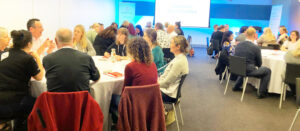2022 IAP2 ‘Digital First Engagement’ Workshop Summary
In October 2022, a group of engagement professionals converged in Melbourne for IAP2’s 2022 Conference. It was a welcome return to business as usual, with old friends and colleagues meeting new-to-the-industry fresh faces and rolling their sleeves up together to dive into this Brave. New. World.
On Day 1, we hosted our first Granicus Roundtables as part of the conference’s workshop programs. We tapped into the collective knowledge of a room of experienced professionals, who shared their experiences, challenges, successes, and goals. So, what did this group of seasoned engagement professionals and fresh new voices bring to the conversation? Each table brainstormed an individual, but meaty topic: Organisational Buy-In; Social Media as an Engagement Project; Hard to Reach, Easy to Ignore; and Post the Pandemic.

Organisational Buy-In
This topic felt familiar to most of our in-room professionals. Demonstrating the value and importance of quality community engagement to cross-functional teams within an organisation can be a challenge that ebbs and flows depending on leadership and organisational directives.
Organisations who felt they’d come a long way with their internal buy-in arrived at a place of good internal understanding through tenacity and consistency. Tenacity is essential as we recognise internal buy-in doesn’t happen overnight but takes considerable time and long-term planning. This tenacity is underpinned by consistency: consistently training, recognising and partnering with ‘internal champions,’ and devising and setting up guidelines and frameworks to embed best practice engagement at an organisational level.
Some of our workshoppers advocated for starting at the top by grabbing a seat at the table with executive decision makers, senior management, and CEOs to champion the importance of including community engagement in the main pillars of organisational strategy.
Suggestions for weaving community engagement into every business area included adding organisational community engagement requirements into position descriptions and making engagement policy and frameworks integral to the onboarding process. One participant’s organisation budgets and delivers inhouse IAP2 training for internal stakeholders, and another focused on internal education driven by the inhouse community engagement team.
Underpinning all of this is the benefit of planning, scheduling, and constantly evaluating engagement activities to deliver clear processes and expectations for internal stakeholders to follow.
Social Media as an Engagement Tool?
This spirited discussion gave us all plenty to ponder. In recent years, we’ve seen new players enter the busy social media landscape (hello BeReal and TikTok), seen some dubious data-handling practices exposed, and watched as tech billionaires construct and deconstruct empires with the click of a button or tweak of an algorithm.
At this roundtable, there was widespread recognition that social media had changed marketing forever, and that it is an extremely valuable mechanism for promoting and driving traffic to dedicated digital and face-to-face events. The ability to target stakeholder groups with focused advertising and a relatively small budget was seen as an accessible way to ensuring your project is hearing from relevant and diverse stakeholders.
Our participants felt that by working closely with marketing and communications teams, social media provided exciting potential to build a dedicated community, and to widen reach when reporting back on engagement outcomes or project progression.
Of course, all of this is not without its challenges, and as helpful as social media can be for reaching marketing communications goals, it can be a tricky environment to navigate for pure community engagement. Low organisational appetite for risk, recent defamation cases, and fear of creating a toxic online culture have led many organisations to minimise or remove the ability for social media posts to accept comments.
Staff capacity was also a consideration. If comments are enabled and you’re actively engaging with your audience, and moderating viral comment threads, how many hours does this cost the organisation? Are you duplicating work if you’re already collecting feedback via dedicated digital engagement platforms with inbuilt 24/7 moderation? And even if the data is moderated and handled sensitively on social media, how do you report on this? Social media tends to be optimised for front end participation and doesn’t have a hugely responsive admin experience, nor does it offer advanced reporting and insights which our participants found challenging and time consuming to overcome.
Hard to Reach, Easy to Ignore
Here, we focused on the who, the why, and how we can reach these groups. Most groups agreed the traditionally hard to reach groups for community engagement included youth, our First Nations community, CALD communities, and those who have a disability or accessibility issue which may act as a barrier for participation.
A few common themes popped up when our professionals debated this.
There was recognition that codesign is a wonderful way to harness these stakeholders and ensure community engagement design is considerate and respectful of unique challenges and barriers.
Participants were also in consensus that building quality relationships with community leaders was integral to diversifying the voices in engagement. It follows that those relationships are strengthened by knowledge and trust, and closing the loop, or reporting back is paramount to achieving this.
Creativity and adaptability were cited as key to delivering a successful engagement to the hard-to-reach. Other suggestions included minimising dense text in favour of videos or spoken words for storytelling, subsidising transport and childcare costs for face-to-face engagement, and potentially compensating people for their time and insights. One group suggested starting by teaching the community so parents, in turn, teach their children about the immense value of being heard.
On the flip side, we heard some wise, but potentially controversial words that are worth sharing: “Some people don’t care. Just leave them alone.”
Post the Pandemic
It wouldn’t be a conference in 2022 without reflection on the wild ride we’ve all enjoyed since 2020. In this discussion, participants looked at how we’ve changed our practice and what we now know in this post-pandemic world.
It was agreed that the pandemic of late 2022 isn’t “finished” as such but is evolving. Although there are less health mandates in place, Covid is very much still a consideration in the engagement space. The groups took time to reflect, starting with the question, “What would you do differently?”
The first social Zoom calls of the pandemic had a novelty factor. We caught up with friends, wore crazy hats, and toasted our health with Saturday night Zoom drinks. Professionally, anyone working as an engagement or communications professional pulled everything out of the bag to redesign and deliver events with a moment’s notice, herding stakeholders into the digital realm with little to no time to prepare them in the subtle art of the mute button.
The lack of lead time for snap lockdowns led to hasty and necessary decisions, and often the simplest solution was delivering face-to-face facilitation online. As the pandemic dragged on, Zoom fatigue kicked in, leaving most practitioners to ponder how they could differentiate themselves and their initiatives, and reignite community engagement.
Upon reflection, our participants felt we could have hit the brakes on the Zoom calls and breakout sessions. Many felt that while online meeting platforms were beneficial, if they had their time again, they’d rely on a wider range of online tools, so stakeholders could drop in and engage in their own time.
Others said they would have embraced traditional methods that initially got lost in our stampede for Zoom, like mail campaigns and conversation kits, or simply picking up the phone to connect with the community.
Working from home was a universally admired side product of the pandemic, but most workshop attendees felt their organisations weren’t up to speed to roll out I.T. equipment which caused more disruption in an already turbulent time.
Flexible working was the main standout in terms of pandemic benefits, but those in the public sector felt governments became nimbler, embracing new technology and ideas much more rapidly than in previous years.
With government decisions having a larger impact on our daily lives than any other time in recent history, anecdotally attendees felt that citizens took a greater interest in government decisions and having their say to produce fairer outcomes. Some participants reported their community became more vocal about government intervention and decisions, and this implored officials to demonstrate greater transparency and commit to valuable and genuine community engagement.
Tying it all together
Our professionals brought so much to the conversation. Industry stalwarts exchanged ideas with up-and-coming engagement enthusiasts, bouncing around new ideas, sharing seasoned insights and perhaps most importantly – celebrating what they’d overcome in the past few years.
All our attendees agreed it was important to celebrate even the smallest of wins. Engagement can be a tough gig so it’s worth regularly reminding yourself how far you’ve come. Some reported the satisfaction in turning around vocal online detractors who became staunch defenders of engagement initiatives, others felt they had a better appreciation of the human capacity for resilience, having watched their communities come together for the greater good and protection of the vulnerable in the past few years.
The collective enthusiasm for learning from each other’s challenges and successes was the real standout from our workshop. Engagement professionals are a close-knit bunch, and we’re all fortunate to have such an open and collaborative community to call our own.
